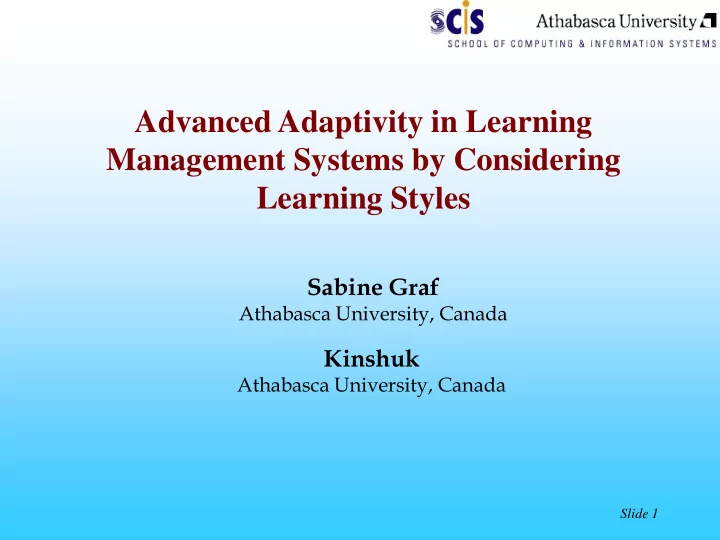

Advanced Adaptivity in Learning Management Systems by Considering Learning Styles Sabine Graf Athabasca University, Canada Kinshuk Athabasca University, Canada Slide 1
Why shall we consider learning styles in LMS? • Learning Management Systems (LMS) are commonly used in e-education but they provide the same course for all learners • Learners have different needs and characteristics • Adaptivity increases the learning progress, leads to better performance, and makes learning easier Slide 2
Aim of Research • Develop an advanced adaptive mechanism that – enables LMSs to automatically consider students’ learning style – allows teachers to adapt the mechanism to their courses (rather than modifying the course to the requirements of the mechanism) Slide 3
Aim of Research • In order to reach this goal we aim at: – developing an advance student modelling approach, using automatic, dynamic and global student modelling – developing a generic framework for providing adaptivity – making both work together Slide 4
General Issues • The adaptive mechanism is developed in a general way but implemented as part of a larger project • This larger project aims at building a personalised mobile learning environment based on different applications/services Slide 5
Felder-Silverman learning style model • Each learner has a preference on each of the dimensions • Dimensions: – Active – Reflective – Sensing – Intuitive – Visual – Verbal – Sequential – Global • Differences to other learning style models: – Combines major learning style models – New way of combining and describing learning styles – Describes tendencies – Describes learning style in more detail Slide 6
Automatic Student Modelling • Detect learners’ characteristics from their behaviour and actions in a course • Procedure: – While students are learning, their behaviour and actions are tracked by the system – Information about students behaviour and actions are used as patterns and used as input for the calculation process of learning styles • Advantages: – No additional work for students – Information is free from the problem of inaccurate self-conceptions of students – analyses data from a specific time span more accurate & allows tracking changes in learning styles Slide 7
Dynamic Student Modelling • Information about students’ behaviour and actions is used for updating the student model frequently • Procedure: – Monitoring students’ behaviour and actions – Once enough evidence is available, revise information in the student model • Advantages: – Allows to response to changes in students’ learning styles – Allows to revise information about students’ learning styles based on their current behaviour and actions Slide 8
Global Student Modelling • Considering data from all applications and services in the student modelling process • Procedure: – Gathering data from all applications/services – Making information in the student model available for all applications/services • Advantages: – More data in order to calculate learning styles more accurately and in less time – One application/service can benefit from the data of other applications/services Slide 9
Advanced Student Modelling Services Adaptive Q&A Location-Aware Mechanism Service Grouping Service Problem-Based Context-Awareness Other Sources Learning Service Service (e.g., Learning Style Social Network Multimedia Questionnaire) Service Input Service Automatic, Dynamic and Global Student Modelling Approach Student Model Slide 10
A Generic Framework of the Adaptive Mechanism • Adapt the adaptive mechanism to teachers preferred course structure and used types of learning objects • Configuration tool: – Which types of learning objects should be considered? – How shall they be considered in an adaptive course? Slide 11
A Generic Framework of the Adaptive Mechanism • Defining a new type of learning object – Which learning style can be supported by the new type? – How is the type of learning object represented in the learning system? – What are suitable adaptation features? • Define adaptation feature based on predefined strategies such as: – Present A before B – Provide a high number of A • For which learning style shall the new adaptation feature be applied? Slide 12
A Generic Framework of the Adaptive Mechanism • After a new type of learning object has been created – Authoring tool is automatically extended so that authors can specify the new type of learning object – Expert model is extended in order to be able to store the new type of learning obejct Slide 13
Provision of Adaptive Courses Slide 14
Conclusions • Adaptive mechanism provides students with advanced adaptivity and is adaptable to teachers’ needs – Automatic, dynamic, and global student modelling – Generic framework – Interaction with students • Future Work – Completing the implementation – Evaluating the mechanism with respect to effectiveness and usability Slide 15
Recommend
More recommend